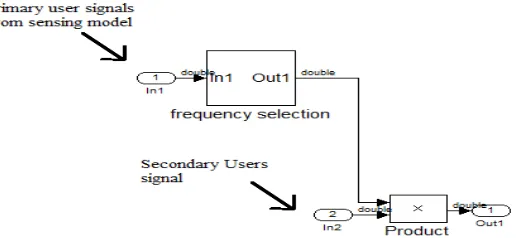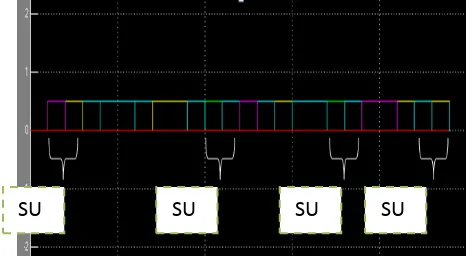ISSN (Print) : 2320 – 3765 ISSN (Online): 2278 – 8875
I
nternational
J
ournal of
A
dvanced
R
esearch in
E
lectrical,
E
lectronics and
I
nstrumentation
E
ngineering
(An ISO 3297: 2007 Certified Organization)
Vol. 4, Issue 12, December 2015
Spectrum Sensing and Allocation In Cognitive
Radio Networks
Bhagyashree Anil Dere
1, Sheetal Bhujade
2P.G. Student, Dept. of Electronics and Telecommunication Engineering, Saraswati College of Engineering,
Navi Mumbai, Maharashtra, India1
Associate Professor, Dept. of Electronics and Telecommunication Engineering, Saraswati College of Engineering,
Navi Mumbai, Maharashtra, India 2
ABSTRACT: With the increasing of communication applications in recent years, the demand for radio spectral
resources has in- creased significantly. Cognitive radio scenario was proposed to improve spectrum efficiency in wireless communication systems. Sensing/monitoring of spectrum-availability has been identified as a key requirement for spectrum allocation in cognitive radio networks (CRNs). In this paper a framework model is designed to detect Primary and Secondary users and each spectrum is characterized by jointly considering primary user activity and spectrum sensing operations. In the final step the decision model is proposed to allocation the spectrum to the cognitive users without affecting the Primary Users. Spectrum decision is the ability of a cognitive radio (CR) to select the best available spectrum band to satisfy secondary users’ (SUs’) quality of service (QoS) requirements, without causing harmful interference to licensed or primary users (PUs).
KEYWORDS: Cognitive Radio, Primary Users (PUs) detection, Secondary Users (SUs) detection, Spectrum
Selection, Spectrum Allocation.
I. INTRODUCTION
ISSN (Print) : 2320 – 3765 ISSN (Online): 2278 – 8875
I
nternational
J
ournal of
A
dvanced
R
esearch in
E
lectrical,
E
lectronics and
I
nstrumentation
E
ngineering
(An ISO 3297: 2007 Certified Organization)
Vol. 4, Issue 12, December 2015
II. LITERATUREREVIEW
Most of the research on spectrum sharing in CR networks has mainly focused on how to efficiently allocate either spectrum or power among CR users subject to interference constraints. Then four main challenges of spectrum management are discussed: spectrum sensing, spectrum decision, spectrum sharing, and spectrum mobility [1]. The control channel plays an important role in exchanging information regarding sensing and resource allocation. Several methods described in [2] are assumed to be used as the common control channel in our proposed method. For spectrum allocation, a global optimization scheme is developed based on graph theory where a general framework is defined which solves the spectrum access problem and maintains overall system utility [3]. However, when the network topology changes according to the node mobility, the network needs to be completely recomputed spectrum assignment leading to a higher computational and communication overhead. To solve this problem, a distributed spectrum allocation based on local bargaining is proposed in [4]. For the resource-constrained networks such as sensor and ad hoc networks, a rule-based spectrum management is proposed, where CR users access the spectrum independently according to both local observation and predetermined rules [5]. In [6] a dynamic channel selection scheme is developed for delay-sensitive applications based on a priority queuing analysis and a decentralized learning algorithm. In [7] issues related the designs of wide band signal path are discussed. In [8] an optimal power allocation scheme is proposed to achieve ergodic and outage capacity of the fading channel under different types of power constraints and fading models. In [9] joint beam-forming and power allocation techniques are presented to maximize the user capacity while ensuring the QoS of primary users. Game theory provides an efficient distributed spectrum sharing scheme by describing the conflict and cooperation among CR users and hence allowing each user to rationally decide on its best action. Thus, it has been widely exploited for both channel allocation [10] and for power allocation [11].A survey of spectrum sensing methodologies for cognitive radio in [12] covers various aspects of spectrum sensing problems are covered and co-operative spectrum sensing concept is discussed. In [13] an overview of the problem of spectrum assignment in cognitive radio networks is given and most basic approaches to overcome this problem have been analyzed. Various aspects of Cognitive radio in [14] discuss the salient features of CR as highly reliable communication and efficient utilization of radio spectrum. In [15] a survey on growing demand of cognitive radio is focused which covers important aspects like spectrum sensing and spectrum allocation for unlicensed users.
III. PRIMARYUSERSDETECTIONINSPECTRUM
In order to allocate the spectrum to primary and secondary users, first the users need to be generated and sensed in a spectrum. Fig1 (a) and fig2 (a) is a simulink model developed to generate primary users in a spectrum. The method of generation of primary users is different in both the figures mentioned.
ISSN (Print) : 2320 – 3765 ISSN (Online): 2278 – 8875
I
nternational
J
ournal of
A
dvanced
R
esearch in
E
lectrical,
E
lectronics and
I
nstrumentation
E
ngineering
(An ISO 3297: 2007 Certified Organization)
Vol. 4, Issue 12, December 2015
Fig 1(b) Generation of Random Primary Users Signals
Fig 2(a) Detection of Primary Users Using Bernoulli Random Number Series
The main system for detection of PUs using Binary number series is shown in fig1 (a) and detection of PUs using Bernoulli series is shown in fig2 (a).
ISSN (Print) : 2320 – 3765 ISSN (Online): 2278 – 8875
I
nternational
J
ournal of
A
dvanced
R
esearch in
E
lectrical,
E
lectronics and
I
nstrumentation
E
ngineering
(An ISO 3297: 2007 Certified Organization)
Vol. 4, Issue 12, December 2015
The Bernoulli series generates the non-repetitive sequence of signals. The main difference between fig1(b) and fig2(b) is that the earlier graph is generated using QAM technique whereas the other signal is generated using Bernoulli series. Further these five random signals are combined together and given to the workspace for comparing it with the Secondary Users or unlicensed users signal. The PUs signal is fed to the spectrum sensing block.
Fig 3(a) Spectrum Sensing Model
Data collected from multiple Primary Users is given to the spectrum sensing model as shown in fig 3(a). Spectrum sensing model consists of various blocks with different functions. The Buffer block redistributes the input samples to a new frame size. It collects the primary users’ signals and sends the signals to the reshape block. The Reshape block changes the dimensionality of the input signal to a 2-D signal. The unbuffer block adjusts the output rate so that the sample period is the same at both the input and output.
Fig 3(b) PUs sensed for Random Number series Generator
Fig 3(c) PUs sensed by Bernoulli Number Series Generator
ISSN (Print) : 2320 – 3765 ISSN (Online): 2278 – 8875
I
nternational
J
ournal of
A
dvanced
R
esearch in
E
lectrical,
E
lectronics and
I
nstrumentation
E
ngineering
(An ISO 3297: 2007 Certified Organization)
Vol. 4, Issue 12, December 2015
Fig 4(a) Secondary Users detection in Spectrum
Fig4(b) Random signals for Secondary Users
IV. RESULTANDDISCUSSION
The Secondary Users signal and the Primary Users signals which are sensed in a sensing model are fed to the frequency selection block shown in fig5 (a) and further the product of Primary and Secondary Users is taken and Spectrum allocation is done as per the presence of users in a spectrum in fig5 (b) and (c).
ISSN (Print) : 2320 – 3765 ISSN (Online): 2278 – 8875
I
nternational
J
ournal of
A
dvanced
R
esearch in
E
lectrical,
E
lectronics and
I
nstrumentation
E
ngineering
(An ISO 3297: 2007 Certified Organization)
Vol. 4, Issue 12, December 2015
Fig 5(b) Spectrum allocation for PUs and SUs for Binary Number Series
Fig 5(c) Spectrum allocation for PUs and SUs for Bernoulli’s Series Generator
The main difference in spectrum allocation done is that in fig 5(b) the binary number series is used for signal generation where 0 means user is absent and 1 means user is present whereas fig 5(c) uses Bernoulli’s series generator which generates series of non-repetitive signals using binary numbers
.
V. CONCLUSION
The main purpose of spectrum sensing and allocation is to utilize the spectrum efficiently. In this work a spectrum allocation scheme is proposed so that Secondary users or cognitive users can also use the unused spectrum when a licensed or primary user is absent in the spectrum. Cognitive radio is different from conventional radios as conventional radios sees vacant spectrum as interference whereas cognitive radio sees vacant spectrum as an opportunity.
REFERENCES
[1] I.F. Akyildiz, W.-Y. Lee, M.C. Vuran, and S. Mohanty, “A Survey on Spectrum Management in Cognitive Radio Networks,” IEEE Comm. Magazine, vol. 46, no. 4, pp. 40-48, Apr. 2008.
[2] D. Cabric, S.M. Mishra, D. Willkomm, R. Brodersen, and A. Wolisz, “A Cognitive Radio Approach for Usage of Virtual Unlicensed Spectrum,” Proc. 14th IST Mobile and Wireless Comm. Summit, June 2005.
[3] C. Peng, H. Zheng, and B.Y. Zhao, “Utilization and Fairness in Spectrum Assignment for Opportunistic Spectrum Access,” ACM Mobile Networks and Applications, vol. 11, no. 4, pp. 555-576, Aug. 2006.
[4] L. Cao and H. Zheng, “Distributed Spectrum Allocation via Local Bargaining,” Proc. IEEE Sensor and Ad Hoc Comm. and Networks (SECON), pp. 475-486, Sept. 2005.
[5] L. Cao and H. Zheng, “Distributed Rule-Regulated Spectrum Sharing,” IEEE J. Selected Areas in Comm., vol. 26, no. 1, pp. 130- 145, Jan. 2008. [6] H. Shiang and M. Schaar, “Queuing-Based Dynamic Channel Selection for Heterogeneous Multimedia Applications over Cognitive Radio Networks,” IEEE Trans. Multimedia, vol. 5, no. 10, pp. 896-909, Aug. 2008.
ISSN (Print) : 2320 – 3765 ISSN (Online): 2278 – 8875
I
nternational
J
ournal of
A
dvanced
R
esearch in
E
lectrical,
E
lectronics and
I
nstrumentation
E
ngineering
(An ISO 3297: 2007 Certified Organization)
Vol. 4, Issue 12, December 2015
[7] Behzad Razavi, “Cognitive Radio Design Challenges and Techniques,” IEEE Journal Of Solid-State Circuits, VOL. 45, NO. 8, AUGUST 2010. [8] X. Kang, Y. Liang, A. Nallanathan, H. Garg, and R. Zhiang, “Optimal Power Allocation for Fading Channels in CR Networks: Ergodic Capacity and Outage Capacity,” IEEE Trans. Wireless Comm., vol. 8, no. 2, pp. 940-950, Feb. 2009.
[9] L. Zhang, Y. Liang, and Y. Xin, “Joint Beam forming and Power Allocation for Multiple Access Channels in Cognitive Radio Networks,” IEEE J. Selected Areas in Comm., vol. 26, no. 1, pp. 38-51, Jan. 2008.
[10] R. Etkin , A. Parekh, and D. Tse, “Spectrum Sharing for Unlicensed Bands,” IEEE J. Selected Areas in Comm., vol. 25, no. 3, pp. 517-528, Apr. 2007.
[11] M.R. Chari, F. Ling, A. Mantravadi, R. Krishnamoorthi, R. Vijayan, G.K. Walker, and R. Chandhok , “FLO Physical Layer: An Overview,” IEEE Trans. Broadcasting, vol. 53, no. 1, pp. 145-159, Mar. 2007.
[12] Tevfik Yucek and Huseyin Arslan, “A Survey of Spectrum Sensing Algorithms for Cognitive Radio Applications,” IEEE Communications Surveys & Tutorials, vol.11, no.1, First Quarter 2009.
[13] EliasZ.Tragos, Sherali Zeadally, AlexandrosG.Fragkiadakis and Vasilios A. Siris , “Spectrum Assignment in Cognitive Radio Networks: A Comprehensive Survey,” IEEE Communications Surveys & Tutorials, vol.15,no.3, pp. 1108 – 1135, Jan.2013.
[14] Simon Haykin, “Cognitive Radio: Brain-Empowered Wireless Communications,” IEEE Journal on selected areas in communications, vol. 23, no. 2, FEB 2005.




